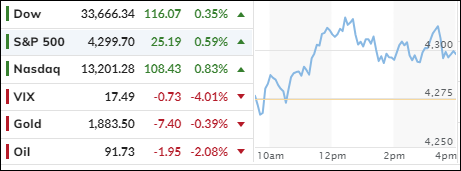
- Moving the markets
Stocks finally got off the floor on Thursday and clung to their gains until the end, as investors watched the wild swings in the bond market with bated breath.
After weeks of getting hammered, the market needed a bounce. A massive short squeeze helped the bulls but don’t get too excited. This rally might fizzle out by next week.
The 10-year Treasury yield soared to a new 15-year high in the morning, as the latest data showed fewer people filing for unemployment benefits than expected. The stock market has been following the bond market like a lost puppy lately.
Any spike in rates makes investors nervous about a recession and sends stocks tumbling. The S&P 500 hit its lowest level since June this week as the 10-year yield reached its highest since 2007.
Friday is the last day of a rough month and quarter for the market. The S&P 500 is set to end the month down 5% and the quarter down 4%. The Nasdaq is doing even worse, losing more than 6% this month and more than 5% this quarter.
Traders will be looking at the latest inflation report on Friday. The PCE index is the Fed’s favorite measure of inflation and, thanks to rising oil prices, it might back up their stance of keeping rates high for longer.
On the economic front, we saw that pending home sales dropped more than expected in August (-7.1% vs. -1%), showing how hard it is for buyers to afford a home with higher interest rates. Jobless claims fell to their lowest level in a year.
Bond yields spiked in the morning but calmed down in the afternoon, giving the rally some breathing room. As yields fell, the dollar lost its mojo and pulled back from its highs. Gold, which usually likes a weaker dollar, dropped, and gave up its $1,900 mark. Oil prices hit $95 overnight, but then lost steam and fell below $92.
Will tomorrow’s inflation report spoil the party?
Stay tuned.
2. “Buy” Cycle (12/1/22 to 9/21/2023)
The current Domestic Buy cycle began on December 1, 2022, and concluded on September 21, 2023, at which time we liquidated our holdings in “broadly diversified domestic ETFs and mutual funds”.
Although our International TTI has experienced a slight dip below its long-term trend line, it was not significant enough to signal the end of that cycle. However, given the potential “Sell” on the horizon, I do not recommend considering this arena as an investment choice.
We have kept some selected sector funds. To make informed investment decisions based on your risk tolerance, you can refer to my Thursday StatSheet and Saturday’s “ETFs on the Cutline” report.
Considering the current turbulent times, it is prudent for conservative investors to remain in money market funds—not bond funds—on the sidelines.
3. Trend Tracking Indexes (TTIs)
The markets recovered slightly after being too low for too long. Our Trend Tracking Indexes (TTIs) barely moved, and the international one stayed close to its trend line, which means it is not clearly bullish or bearish.
This is how we closed 09/28/2023:
Domestic TTI: -2.30% below its M/A (prior close –2.98%)—Sell signal effective 9/22/2023.
International TTI: +0.11% above its M/A (prior close -0.32%)—Buy signal effective 12/1/2022.
All linked charts above are courtesy of Bloomberg via ZeroHedge.
Contact Ulli